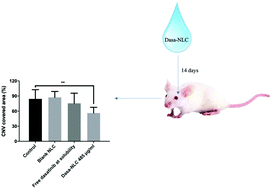Dasatinib loaded nanostructured lipid carriers for effective treatment of corneal neovascularization†
Abstract
Corneal neovascularization (CNV) is one of the most important causes of visual impairment worldwide. Dasatinib, a poorly water-soluble tyrosine kinase inhibitor with dual Src family kinase and platelet derived growth factor receptor inhibiting capability, has great potential in the treatment of CNV. In this study, dasatinib was successfully encapsulated into a nanostructured lipid carrier (Dasa-NLC) and the size was approximately 78 nm with a small polydispersity index. The NLC increased the solubility of dasatinib by more than 1220 times, sustained the drug release, reduced the ocular toxicity and facilitated its penetration into the cornea. Dasa-NLC significantly inhibited the proliferation, migration and tube formation of HUVEC cells, the three most important angiogenesis-related cellular changes of the CNV. Next, the in vivo anti-CNV effect of Dasa-NLC was evaluated using an alkaline burned mice CNV model, in which the development of the CNV and pathological changes of the cornea were significantly inhibited. The immunohistochemistry analysis indicated that Dasa-NLC could inhibit both the expression and activation of Src family kinase, a key component in the angiogenesis cascade. Therefore, Dasa-NLC showed considerable promise in the treatment of CNV.



 Please wait while we load your content...
Please wait while we load your content...